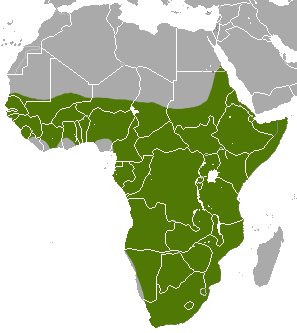Aardvark
The aardvark (Orycteropus afer) is a mammal from Africa; its name means "earth pig" in the language Afrikaans. It is the only living member in its order, though some fossil genera have been found
| Aardvark | |
|---|---|

| |
| Conservation status | |
| Scientific classification | |
| Kingdom: | Animalia |
| Phylum: | Chordata |
| Order: | Tubulidentata |
| Family: | Orycteropodidae |
| Genus: | Orycteropus |
| Species: | O. afer
|
| Binomial name | |
| Orycteropus afer (Pallas, 1766)
| |
| Subspecies | |
|
See text | |

| |
| Aardvark range | |
Taxonomy
- Order Tubulidentata
- Family Orycteropodidae
- Genus Orycteropus
- Species Orycteropus afer
- Genus Orycteropus
- Family Orycteropodidae
The Aardvark looks a bit like the South American anteaters but they are not related. It is in a proposed clade Afroinsectiphilia, with the golden moles and tenrecs. Another proposal is to out it in the Pseudungulata, with the elephants and Sirenia. There is no consensus at present.
Description
Adult aardvarks weighs about 60 kilograms (130 pounds) and a little more than one meter (45 inches) long. It is the largest member of the proposed clade Afroinsectiphilia. The aardvark is pale yellowish-gray in color and often stained reddish-brown by soil. The aardvark's fur is thin. Its hair is short on its head and tail. But, its legs tend to have longer hair.[2]
Distribution and Habitat
Aardvarks are found in sub-Saharan Africa.[3] They are found in every country in sub-Saharan Africa except Namibia, Ivory Coast, Ghana and Madagascar.[4] It lives in many habitats like savannas, grasslands, woodlands and bushland. They have been seen as high as 3,200 metres (10,500 ft) in Ethiopia.[3]
Feeding
Aardvarks eat mostly ants and termites. They have a long sticky tongue which makes it easy to pick up many ants at once. The only fruit that aardvarks eat is the aardvark cucumber.[5] They avoid eating the African driver ant and red ants.[5]
Behaviour
Aardvarks are nocturnal, which means they are awake at night and asleep during the day. The aardvark is a good swimmer. It can dig a tunnel that is one yard in about five minutes.[5] Aardvarks live for up to 23 years in captivity.[5] It has many predators such as lions, leopards, cheetahs, African wild dogs, hyenas, and pythons.[6][5] Some humans also hunt aardvarks for meat.[6] Aardvarks can dig fast or run in a zigzag to confuse predators. If all else fails they will attack with their claws.[5]
Reproduction
Aardvarks only come together to breed. The gestation period is seven months.[2] They give birth to one cub, which is what a baby aardvark is called. The cub weighs around 1.7–1.9 kilograms (3.7–4.2 lb).[5] It is born during May–July.[6] After 5–6 weeks, hair starts growing on its body. After two weeks, it is able to leave the burrow to follow its mother. After 9 weeks, it is able to eat termites. It is weaned between three months and 16 weeks.[5] At six months, it is able to dig its own burrows, but it will often stay with the mother until the next mating season.[2] It reaches sexual maturity when it is two years old.[5]
References
| Wikispecies has information on: Orycteropus afer. |
| Wikimedia Commons has media related to Lua error in Module:Commons_link at line 62: attempt to index field 'wikibase' (a nil value).. |
- ↑ Lindsey and others 2008
- ↑ 2.0 2.1 2.2 The Encyclopedia of mammals. Macdonald, David W. (David Whyte). New York, NY: Facts on File. 1984. ISBN 0-87196-871-1. OCLC 10403800.
{{cite book}}: CS1 maint: others (link) - ↑ 3.0 3.1 "This insect-eater belongs to the same group of mammals as the elephant". African Wildlife Foundation. Retrieved 2020-09-21.
- ↑ Authority), Andrew Taylor (IUCN SSC Afrotheria Red List; Thomas Lehmann (Senckenberg Research Institute and Natural History Museum Frankfurt, Germany) (2014-01-21). "IUCN Red List of Threatened Species: Orycteropus afer". IUCN Red List of Threatened Species. Retrieved 2020-09-21.
- ↑ 5.0 5.1 5.2 5.3 5.4 5.5 5.6 5.7 5.8 Grzimek's encyclopedia of mammals. Grzimek, Bernhard. (English language ed ed.). New York: McGraw-Hill Publishing Company. 1990. ISBN 0-07-909508-9. OCLC 20014856.
{{cite book}}:|edition=has extra text (help)CS1 maint: others (link) - ↑ 6.0 6.1 6.2 Collier's encyclopedia. 24 vols. [Place of publication not identified]: Collier's. 1997. ISBN 1-57161-093-6. OCLC 656144659.
